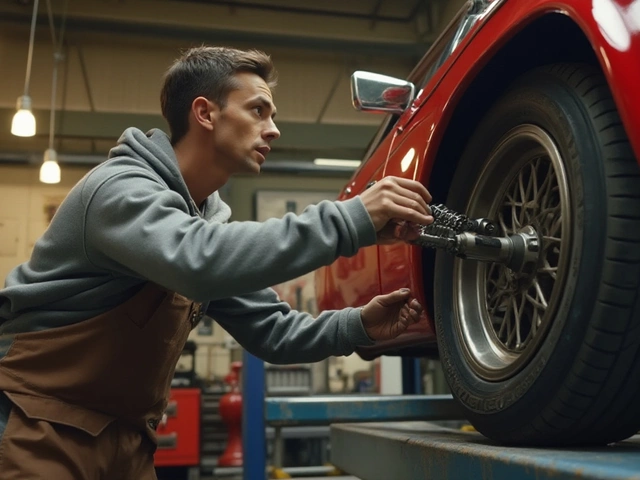Ever seen someone’s car squatting so low it looks like it’s scraping ants off the pavement, and thought, “Dang, that’s cool—but is that really good for the car?” I’ve been there. Plenty of Troy’s friends show up with cars inching from the ground, all for the street cred and style points. Doesn’t mean those slammed rides are getting a gentle pat from the mechanics, though. The big question everyone’s got: do lowering springs actually mess up your car, or is that just something grumpy old car guys say? There’s a lot of noise about this topic, and I’m laying it all out—every cost, benefit, headache, and shortcut actual drivers deal with.
What Lowering Springs Do—And Why People Use Them
Lowering springs replace your car’s original coil springs, shaving anywhere from half an inch to two full inches off the ride height. The logic is straightforward: lower the center of gravity, tighten up cornering, and give your car a more aggressive, modern stance. You see it everywhere, from city streets to track weekends. At first glance, installing lowering springs seems like a win-win—better looks, possibly better performance, and even improved aerodynamics.
But it’s easy to gloss over what’s really happening under the surface. Factory springs are carefully matched with your car’s weight, dampers (shocks), and everyday driving conditions. When you swap those out for lowering springs, you’re changing not just the way your car looks, but the way every component in the suspension system talks to each other. A stiffer, shorter spring means the suspension has less "room" to soak up bumps and potholes. That gets you less body roll in corners, which sounds great until you hit a construction zone or railroad tracks—then every jolt rattles your teeth.
Plenty of people believe they’re getting race car vibes in a daily driver, but there’s a line between handling upgrades and sacrificing comfort. Ever been in a car with lowering springs on a rough road? My back remembers every bump. Some drivers like the raw, responsive feel, but for families or commuters, the fun can wear off fast—especially when kids like Troy start asking why the ride's so bouncy.
How Lowering Springs Affect Your Suspension and Ride
This is where things get real. Lowering springs compress the car’s stock suspension travel. We’re talking two major issues: first, you increase the risk of bottoming out, which happens when the shock absorber hits its limit and can’t cushion the impact anymore. Second, you stress out components that were designed for a different geometry.
Your shocks, for one, have a set range of movement. Drop your car too much, and you force your shocks to run in a compressed position all the time. That extra pressure can make shocks wear out two or three times faster than they would on stock suspension. A 2018 consumer study by Bilstein, a well-respected suspension brand, found that vehicles lowered over 1.5 inches reported shock failure 45% more often than standard ride height vehicles. That’s not something a mechanic just made up to sell you parts.
Bushings, ball joints, and tie rods—all those bits connecting your wheels and chassis—also take a beating. Since they’re now angled more sharply, they wear out quicker and can even separate if things get bad enough. Alignment issues start popping up after even a modest drop, pulling your wheels out of optimal camber and toe. This means the tires wear unevenly, reducing their lifespan. I had to buy Troy new sneakers last month, but at least his only cost fifty bucks. For a set of performance tires, you’re looking at over $1,000, so uneven tire wear hurts a lot more.
Let’s look at a comparison.
| Feature | Stock Suspension | Lowered (Springs Only) |
|---|---|---|
| Ride Comfort | Optimized for daily use | Stiffer, more road feedback |
| Shock Absorber Life | 50,000-100,000 miles | 20,000-40,000 miles (with >1.5" drop) |
| Tire Wear | Even | Uneven if not aligned/corrected |
| Handling | Safe and predictable | Better cornering, but compromised if too low |
People often find out what’s wrong the hard way. You swap springs, everything seems golden, but six months in, you’re on your second set of rear shocks and always realigning your wheels. Sure, there are ways to fix the geometry (aftermarket adjustable control arms, better shocks), but those solutions add up quickly in cost and time.

Practical Issues: From Speed Bumps to Insurance
Life isn’t just about the open road. Take it from someone who’s had a car stuck on a parking curb because I forgot how low I was sitting—lowering springs introduce headaches you might not anticipate. First and most obviously, your beloved car is now a magnet for rubbing, scraping, and cracked bumpers. With a lowered setup, especially under two inches clearance, you have to train yourself to angle over every speed bump and take driveways at a snail’s pace. My son Troy laughs every time I stop him from jumping in the car the "wild way," because I know one bad bounce and we’ll scrape something important.
Ever get stuck in the rain with deep puddles? Lowering puts key components like the oil pan and exhaust dangerously close to road hazards. I know a guy who cracked his oil pan on a chunk of concrete after a summer storm, and it wasn’t pretty—or cheap. Hydrolocking the engine or damaging the underbody is a real possibility. In winter, you’ll plow through snow instead of gliding over it.
There's also the insurance catch. Lowering your car might not seem like a big enough deal to notify your provider, but some carriers count it as a modification that can void your coverage. Didn’t mention it and then total the car? Good luck with that claim. According to a 2022 report by J.D. Power, modified suspension setups are flagged by insurance adjusters in up to 29% of collision claims involving lowered cars.
Emissions inspections can throw a wrench in your plans too—particularly if an overly aggressive lowering job messes up your car’s headlight aim or makes emission equipment scrape or fail visual checks. Local laws can be weirdly strict; some cities (like San Francisco and certain Montreal neighborhoods) set minimum clearance requirements. Get caught out of spec and you could see tickets or get forced to return your car to factory ride height. It’s a lot more than just picking up a new look in a weekend.
Lowering Springs: How to Get the Look Without Regret
No need to scare you off completely. Tons of people use lowering springs for years without big issues—but only when they don’t cut corners. If you still want the look and handling boost, you need to go in with realistic expectations and a plan.
First tip: stick to a modest drop. Anything around an inch will usually keep things drivable, avoid wrecking your shocks too quick, and help you clear those speed bumps. Pick reputable brands—Eibach, H&R, and Tein are three that consistently get solid reviews for reliability and tuning. Generic no-name kits from random online stores often have inconsistent spring rates, which can turn any car into a pogo stick or worse, bottom out with every bump.
Combine the springs with shocks or struts designed for lower ride heights. It sounds boring, but matched dampers last much longer and give far better ride comfort. Bilstein and Koni both make "sport" shocks for this purpose. Skipping this (just throwing springs on stock shocks) is the nail in the coffin for your setup’s lifespan and your daily comfort.
Next, get a professional alignment after the springs are installed. Even a mild drop tweaks your suspension geometry enough to make “eyeballing” the job worthless. Camber kits help regain that lost alignment, and you’ll save money in the long run by not eating through tires every 10,000 miles.
Keep an eye on your car—listen for unusual noises and have the suspension checked at oil changes. If you’re putting on a bunch of miles or drive in places with brutal road conditions, adjust your expectations. And always, always check your insurance company’s stance before you dive in.
- If you want the lowered look but not the drama, consider coil-over kits—more expensive but much more adjustable, so you can tweak ride height as conditions change or add lift for winter.
- Don’t chop your stock springs. It might seem like an easy shortcut, but it’s dangerous and can ruin your suspension immediately.
- If your car is a daily driver that sees lots of people, rough roads, or wintery weather, maybe dial back how low you go.
So, do lowering springs mess up your car? They can, if you’re careless or greedy about the look. But if you pick quality parts, stay realistic about how low you go, and look after the whole suspension system—not just slap on new springs—you can get the style and driving feel you want, without all the drama. Just make sure you do the homework and don’t buy “too good to be true” parts off late-night shopping sprees.




